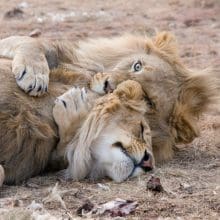The Tiger’s Gaze: How Do Tigers Hunt Their Prey in the Jungle?
The Tiger’s Gaze
The Tiger’s Gaze Will Meet Yours a Hundred Times Before You Catch a Glimpse of This Elusive Predator.
Tigers are majestic creatures that have captivated humans for centuries. With their powerful build, sharp claws, and piercing gaze, they are known as one of the most skilled hunters in the animal kingdom. In this article, we will explore the fascinating hunting techniques employed by tigers in the jungle.
The Stealthy Stalk
When it comes to hunting, tigers are masters of stealth. They rely on their excellent camouflage and patience to get as close as possible to their prey without being detected. Their orange and black striped fur helps them blend seamlessly into the dappled sunlight and shadows of the jungle, making them almost invisible to their unsuspecting victims.
Once a tiger spots its prey, it crouches low to the ground and moves silently, taking advantage of the dense vegetation to conceal its approach. This slow and deliberate stalking allows the tiger to get within striking distance without alerting its target.
The Ambush Attack
When the time is right, the tiger launches a lightning-fast ambush attack. With a burst of speed, it pounces on its prey, using its powerful forelimbs and sharp claws to bring it down. Tigers have been known to leap up to 30 feet in a single bound, making them incredibly agile and deadly.
One of the most remarkable aspects of a tiger’s attack is its ability to go for the kill with a single bite to the neck or throat. Their strong jaws and sharp canine teeth can easily puncture the jugular vein or sever the spinal cord, ensuring a swift and humane death for their prey.
Targeting the Weak
The Tiger’s Gaze: Tigers are opportunistic hunters and will target a wide range of prey, including deer, wild boar, and even larger animals like buffalo and gaur. However, they are not indiscriminate killers. Tigers are intelligent predators that carefully select their targets, focusing on the weak, injured, or old individuals within a herd.
By targeting the weak, tigers increase their chances of a successful hunt while minimizing the risk of injury. Weaker prey are slower and less agile, making them easier to catch and overpower. This strategy ensures that tigers conserve their energy and minimize the risk of injury during the hunt.
Adapting to Different Environments
Tigers are incredibly adaptable creatures and can be found in a variety of habitats, from dense jungles to grasslands and even mangrove swamps. Their hunting techniques vary depending on the environment they inhabit.
In the dense jungles, tigers rely on their stealth and agility to navigate through the thick undergrowth and surprise their prey. They use the cover of trees and bushes to get as close as possible before launching their attack.
In open grasslands, tigers use a different approach. They take advantage of their speed and camouflage to blend into the tall grass, patiently waiting for the perfect moment to strike. Their powerful hind legs allow them to sprint at incredible speeds, reaching up to 40 miles per hour in short bursts.
Conservation Challenges
The Tiger’s Gaze: While tigers are formidable hunters, they face numerous challenges in the modern world. Habitat loss, poaching, and illegal wildlife trade have pushed many tiger populations to the brink of extinction. According to the World Wildlife Fund (WWF), there are only around 3,900 tigers left in the wild.
Conservation efforts are crucial to protect these magnificent creatures and ensure their survival. Governments, NGOs, and local communities are working together to establish protected areas, combat poaching, and raise awareness about the importance of tiger conservation.
Conclusion
The Tiger’s Gaze: Tigers are truly remarkable hunters, employing a combination of stealth, speed, and strength to secure their prey. Their ability to adapt to different environments and select the weakest individuals within a herd showcases their intelligence and strategic thinking.
However, the future of tigers is uncertain. It is our responsibility to protect these magnificent creatures and ensure that future generations can witness the awe-inspiring sight of a tiger’s gaze in the jungle.
Discover the Untamed Beauty of Big Cats: Explore the Enchanting Stories of Big Cat Rescue





